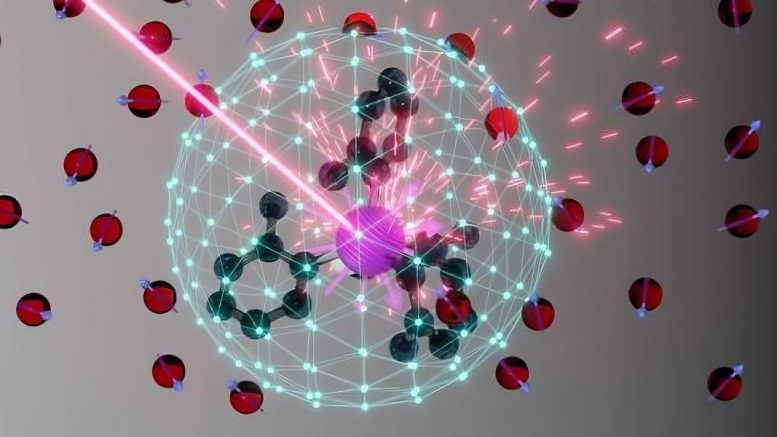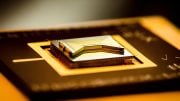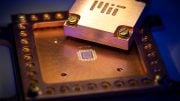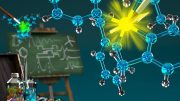
Scientists have shown they can extend the lifetime of a molecular qubit by changing the surrounding crystal’s structure to be less symmetrical. The asymmetry protects the qubit from noise, enabling it to maintain information for five times longer than if it were housed in a symmetrical structure. Credit: MIT/Dan Laorenza
Stability in Asymmetry
By breaking the symmetry of their environment, scientists demonstrate a new technique for extending the length of time qubits can retain information.
What happened
Scientists have shown that by changing the surrounding crystal’s structure to be less symmetric, they may prolong the lifetime of a molecular qubit.
The qubit is protected from noise by the asymmetry, allowing it to preserve information five times longer than if it were housed in a symmetrical structure. The study team obtained a coherence time (the time the qubit maintains information) of 10 microseconds, or 10 millionths of a second, compared to a molecular qubit’s coherence time of 2 microseconds in a symmetrical crystal host.
The findings, which were published in the journal Physical Review X, were produced by a group of scientists from the Massachusetts Institute of Technology, Argonne National Laboratory of the US Department of Energy (DOE), Northwestern University, The University of Chicago, and the University of Glasgow. Q-NEXT, a DOE National Quantum Information Science Research Center run by Argonne, helped fund the research.
A bit of background
- A qubit is the fundamental unit of quantum information, the quantum analog of a traditional computing bit.
- Qubits can hold on to information for only so long before noise, or interfering signals, destroys the information. Extending the length of time the information remains stable, known as the coherence time, is one of the biggest challenges in quantum information science.
- Qubits come in different types, one of which is a lab-engineered molecule. Molecular qubits are modular, meaning they can be moved from one environment and placed in another with ease. By contrast, other types of qubits, such as those made of semiconductors, are highly wedded to their environment.
Why it matters
- Longer coherence time: Longer coherence times make for more useful qubits in applications such as computing, long-distance communication, and sensing in areas such as medicine, navigation, and astronomy.
- Modularity: Because the coherence time can be stretched by altering the qubit’s housing or by placing it in a more asymmetrical position relative to its housing, there’s no need to change the qubit itself to achieve longer lifetimes. Just change its situation.
“Molecular chemistry enables us to swap out the crystalline material that hosts the qubit as well as modify the qubit itself,” said Danna Freedman, F.G. Keyes Professor of Chemistry at MIT and paper co-author. “Adding in this new level of control is very powerful.”
“The change was realized just by interchanging single atoms on the host molecules, one of the smallest changes you could get, and it gave rise to the five-fold enhancement in coherence time,” said the University of Glasgow’s Sam Bayliss, who co-authored the study. “It’s a nice demonstration of this atomic-level tunability that you get with molecules. Chemical techniques intrinsically provide control on the level of single atoms, which is a dream in a lot of modern technologies.”
- Variability: The effectiveness of this symmetry-breaking technique means that molecular qubits can operate in a wide variety of environments, even those in which noise can’t be reduced.
“We’ve created a new handle for modifying coherence properties in molecular systems,” Freedman said. “This newfound ability to chemically control the host environment opens up new space for targeted applications of molecular qubits.”
“While 10 microseconds may not sound extremely long compared to some systems, keep in mind that we didn’t do anything to reduce the noise sources. In the environments we measured, the noise is very significant. So even though there’s noise there, the qubits basically don’t see it,” Bayliss said. “And why don’t we just remove the noise source? In practical cases, it’s not always possible to operate in an environment that is ultrapure. So having a qubit that can operate intrinsically in a noisy environment can be advantageous.”
The details
- The team’s qubit is made of a chromium-based ion attached to carbon-based molecules.
- For a molecular qubit, the main source of noise is the magnetic fields in its surroundings. The magnetic fields tend to jostle the qubit’s energy levels, which encode the information. The crystal’s asymmetry shields the qubit from the potentially disruptive magnetic fields, and the information is preserved for longer.
- In addition to improving the qubit’s properties, the team developed a mathematical tool that accurately predicts any molecular qubit’s coherence time based on the structure of the host crystal.
“This is incredibly exciting for us,” Bayliss said. “One of the very exciting things was just how much of an advancement could be made with these systems over a short space of time, and how small some of the modifications to the host matrix can be to get quite a significant improvement.”
“I’m delighted to observe a new, exciting feature of molecular chemistry,” Freedman said.
“This is an important development. Being able to precisely tune a qubit’s environment is a unique advantage of molecular qubits. This can’t be easily done within other material systems,” said Q-NEXT Director and paper co-author David Awschalom, who is also an Argonne senior scientist, vice dean of Research and Infrastructure and the Liew Family Professor of Molecular Engineering and physics at the University of Chicago’s Pritzker School of Molecular Engineering, and the director of the Chicago Quantum Exchange. “Knowing we can extend a qubit’s lifetime by engineering its environment opens new possibilities for applications across quantum computing, sensing, and communication.”
Reference: “Enhancing Spin Coherence in Optically Addressable Molecular Qubits through Host-Matrix Control” by S. L. Bayliss, P. Deb, D. W. Laorenza, M. Onizhuk, G. Galli, D. E. Freedman and D. D. Awschalom, 18 August 2022, Physical Review X.
DOI: 10.1103/PhysRevX.12.031028
The study was funded by the U.S. Department of Energy Office of Science National Quantum Information Science Research Centers and the Office of Basic Energy Sciences.








The origin of the asymmetry of matter is one of the most challenging problems in particle physics and cosmology. Asymmetry is a representation, while symmetry is fundamental. The interactions and balances of topological vortex fields cover all short-distance and long-distance contributions of space-time motion, and are the basis of the formation and evolution of cosmic matter. Scientific research under the guidance of correct theories can make human less detours and less failures. Good luck to your team.